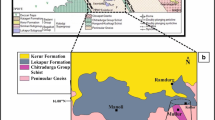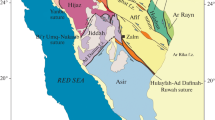Abstract
Kaladgi basin aging palaeoproterozoic to neoproterozoic is an area of intriguing geological past. The basin had been under various phases of deformation for which emphatic evidences have been thoroughly studied which includes the field structural data, finite strain analysis and microtectonics to unveil the geological history of the basin. Whenever the intensity of deformation is evidently high, it penetrates to the microlevel and is pronounced well in the grains, which are studied under thin sections. In present study, an approach is made to unravel the patterns, and phases of deformation are studied. A total of nine oriented samples from the study area were subjected to analysis under microscope as thin sections and penetrative microstructures were noted down. Later, these samples were analysed for Strain using EllipseFit software. Considering the Rf/ϕ method for Strain analysis using Flinn Plot, Fry Plot and, Hsu Plot the patterns of the Rs XZ ranges from 1.09 to 1.78 and Rs YZ ranges from 1.05 to 1.69 indicating moderately high strain in the rocks of the area. The analysis of the strained quartz grains shows apparent flattening (0 < K < 1) with respect to the deformation temperature, the area has undergone moderate to moderately high deformation grade condition (moderate to high deformation temperature 250 °C to > 500 °C). Overall, the area has subjected to two phases of deformation, i.e. indicated by the secondary fillings in many grains. The time relation between the crystallization and deformation indicates that the rocks exposed are showing pre-kinematic crystallization.









Similar content being viewed by others
References
Abbasi S, Pourmorad S, Mohanty A (2021) Investigation of petrographic and diagenetic properties of Asmari Reservoir Cap Rock, SW Iran. J Hum Ear Fut 2:447
Borges FS, White SH (1980) Microstructural and chemical studies of sheared anorthosites, Roneval, South Harris. J Struct Geol 2:273–280
Dunnet D (1969) A technique for finite strain analysis using elliptical particles. Tectonophysics 7:117–136. https://doi.org/10.1016/0040-1951(69)90002-X
FD (1956) On the deformation of the Funzie conglomerate, Fetlar, Shetland. J Geol 64:480–505. https://doi.org/10.1086/626380
Flinn D (1962) On folding during three-dimensional progressive deformation. Q J Geol Soc Lond 118:385–428. https://doi.org/10.1144/gsjgs.118.1.0385
Fry N (1979) Random point distribution and strain measurements. Tectonophysics 60:89–105. https://doi.org/10.1016/0040-1951(79)90135-5
Ghosh SK (1993) Structural geology fundamentals and modern developments. Pergamon Press, New York
Hirth G, Tullis J (1992) Dislocation creep regimes in quartz aggregates. J Struct Geol 14:145–159
Hsu TC (1966) The characteristics of coaxial and noncoaxial strain paths. J Strain Anal 1:216–222. https://doi.org/10.1243/03093247V013216
Tullis J, Yund RA (1987) Transition from cataclastic flow to dislocation creep of feldspar: mechanisms and microstructures. Geol 15(7):606–609. https://doi.org/10.1130/0091-7613(1987)15%3c606:TFCFTD%3e2.0.CO;2
Jayaprakash AV, Sundaram V, Hans SK, Mishra RN (1987) Geology of the Kaladgi-Badami Basin, Karnataka. Mem Geol Soc India 6:201–226
Ji S (1998) Deformation microstructure of natural plagioclase. In: Snoke A, Tullis J, Todd VR (eds) Fault related rocks–a photographic atlas. Princeton University Press, New Jersey, pp 276–277
Ji S (1998) Kink bands and recrystallization in plagioclase. In: Snoke A, Tullis J, Todd VR (eds) Fault. Springer, Berlin
Kale VS, Ghunkikar V, Paul TP, Peshwa VV (1996) Macrofacies architecture of the first transgressive suite along the southern margin of the Kaladgi Basin. J Geol Soc India 48:75–92
Lyros E, Kostelecky J, Plicka V, Vratislav F, Sokos E, Nikolakopoulos K (2021) Detection of Tectonic and Crustal Deformation using GNSS Data Processing: The Case of PPGnet. Civil Eng J. https://doi.org/10.28991/cej-2021-03091633
Main I, Mair K, Kwon O, Elphick S, Ngwenya B (2001) Experimental constraints on the mechanical and hydraulic properties of deformation bands in porous sandstones; a review. In: Holdsworth RE, Strachan RA, Magloughlin JF, Knipe RJ (eds) The nature and tectonic significance of fault zone weakening. Geol Soc Special Pub, New York, pp 43–63
Mukherjee MK (2015) Basement-cover relations in the intracratonic Kaladgi basin, southwestern India: Deformational evidence of a Mesoproterozoic gravity gliding of the cover over the basement. In: Siégel C, Verdel C, Rosenbaum G (eds) Riding the wave: GSA specialist group in technical and structural geology conference, Geological Society Australia, vol 113, pp 104–105
Nishikawa O, Takeshita T (1999) Dynamic analysis and two types of kink bands in quartz veins deformed under subgreenschist conditions. Tectonophysics 301:21–34
Poirier JP, Guillope M (1979) Deformation induced recrystallisation of minerals. B Mineral 102:67–74
Pryer LL (1993) Microstructures in feldspars from a major crustal thrust zone: the Grenville Front, Ontario, Canada. J Struct Geol 15:21–36
Pujar A, Puniya MK, Hiremath M et al (2021) Study of structural, deformation temperature, and strain analysis of the quartzarenites of south-central Kaladgi basin, exposed at and around Mullur ghat and Kallur village of Belgaum district, Karnataka, India. Arab J Geosci 14:744. https://doi.org/10.1007/s12517-021-06915-9
Pujar AG, Hiremath MC, Hanji CP (2021) Discriminatory analysis for determining the environment of deposition of South-central part of Kaladgi Basin, Belagavi District, Karnataka, India. Dokl Earth Sc 496:24–31. https://doi.org/10.1134/S1028334X21010177
Puniya MK Patel RC, Pant PD (2019) Structural and Thermochronological studies of the Almora Klippe, Kumaon, NW-India: Implications for Crustal thickening and exhumation of the NW-Himalaya., Geological Society, London, Special Publications, vol 481. Doi: https://doi.org/10.1144/SP481-2017-74
Ramsay JG, Huber MI (1983) The techniques of modern structural geology, vol 1. Academic Press, London
Ramsay JG (1967) Folding and fracturing of rocks. McGraw-Hill, New York
Stipp M, Stünitz H, Heilbronner R, Schmid SM (2002) The eastern Tonale fault zone: a “natural laboratory” for crystal plastic deformation of quartz over a temperature range from 250 to 700 °C. J Struct Geol 24:1861–1884
Sukanta D, Rai AK, Anjan C (2009) Palaeoweathering, composition and tectonics of provenance of the Proterozoic intracratonic Kaladgi-Badami basin, Karnataka, southern India: evidence from sandstone petrography and geochemistry. J Asian Earth Sci 2:703–71
Ten Grotenhuis SM, Trouw RAJ, Passchier CW (2003) Evolution of mica fish in mylonitic rocks. Tectonophysics 372:1–21
van Daalen M, Heilbronner R, Kunze K (1999) Orientation analysis of localized shear deformation in quartz fibres at the brittle-ductile transition. Tectonophysics 303:83–107
Author information
Authors and Affiliations
Corresponding author
Ethics declarations
Conflict of interest
The authors declare that there is no conflict of interest or any funding received for this research work. This is pure and original research work conducted by the associated authors.
Rights and permissions
About this article
Cite this article
Pujar, A.G., Hanji, C.P., Dharek, M.S. et al. Implication of stress behaviour in the rocks exposed along Markhandaya River, with a special emphasis on microstructures and deformation temperature, Gokak, India. Innov. Infrastruct. Solut. 7, 268 (2022). https://doi.org/10.1007/s41062-022-00864-2
Received:
Accepted:
Published:
DOI: https://doi.org/10.1007/s41062-022-00864-2




